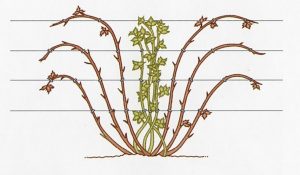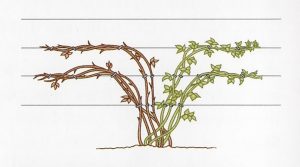There are some jobs that I absolutely dread doing in our edible garden.
Not too many, but some that are so difficult, horrible, or painful that I just don’t want to do them.
Pruning our heritage Boysenberry plants is one of those jobs.
I don’t mind digging around in the worm farm, shoveling compost and making fish fertiliser (oh the smell!) but when I know it’s time to cut back the Boysenberries, somehow weeks and months drift by and I still haven’t done it.
Which means that it was totally overdue to be done and with one month of Winter left, time was running out.
So, last week I finally got onto it.
Well that’s not entirely true actually.
Last week I managed to convince my wonderful husband to help me get onto it and with secateurs, heavy gloves and more training wire in hand, we ventured into the chaos that was our Boysenberry patch.
Since Summer, things have gone a bit feral with the Boysenberry plants. New growth has taken off and spread itself far and wide and becuase of my aforementioned aversion to playing with these guys, I hadn’t trained them.
Plus, I knew we would eventually cut them back so I pretty much just let them go.
Which produced this:
A bit of a mess, I’m sure you’ll agree.
Winter certainly hasn’t been kind to these plants either and between the old, dead leaves and the wandering arms, it was a prickly mess.
So it was time to tame the Boysenberries, and get them back into some order before Spring led them into a lot more new growth.
How To Prune Boysenberries
First and foremost, you don’t have to hold off pruning your Boysenberries like I do. It is recommended that you prune them anytime between Autumn and Winter, once all fruiting has finished.
Boysenberries are a variety of Blackberry (crossed with a Loganberry) and therefore, many of the same principals of pruning Blackberries, apply to pruning Boysenberries.
The first thing to do is to cut back all of the canes that fruited in the Summer just passed. These canes will be dry, brown and becoming woody. Cut them right back to the ground and remove them.
Also cut back any damaged or diseased canes. You don’t want these to remain for your next fruiting season.
Once you have cut back all the unwanted canes, start trimming any canes that have got too long or wide for the structure. Take off the extra length so that you can maintain some form with your Boysenberry plants. If left unclipped, they will travel and spread for miles.
Now the interesting part comes. Make sure you have you gloves on for this because you need to take hold of the new canes and train them into place so that they are tidy and spread out, so they receive enough light, air and also make it easier to pick from.
There are a few different patterns that are common for training Boysenberry canes:
 With this shape you fan out this year’s fruiting canes and then train the new ones up the centre.
With this shape you fan out this year’s fruiting canes and then train the new ones up the centre.
Once fruiting has finished you cut the outer canes off and then train the new canes out.
This is kind of how we work with our Boysenberries.
With this shape you let the new canes trail on the ground while the fruiting canes are trained up.
Once fruiting has finished you cut the trained canes off and then lift the new canes up to be trained.
With this shape you train the fruiting canes to one side, and the new canes to the other side.
Once fruiting is finished you cut the left canes out and then let the new canes on the right fruit the following year.
You then training the next lot of new canes up the left side.
This last option takes a lot more room but makes things very easy.
The End Result
As mentioned, we tend to kind of follow the second option above, training in our fruiting canes and letting the new canes drape along the ground.
So, after cutting back all the old canes and training the new canes, this is what we ended up with:
You can see that things are looking a LOT tidier and in the detailed picture below, you can see that the new canes have plenty of room to grow, leaf up, blossom and fruit.
I’m so happy that this job is finally done.
Not only does it look a lot better, but I know our lovely heritage Boysenberries are in their best state to produce another load of fresh, sweet, juicy Boysenberries.
Boysenberries are one of my favourite fruits so in the end, despite the torture they inflict, I have to keep them growing happily so I can reap the rewards.
And hopefully those last few thorns that are embedded in my husbands hands will come out soon.
Any tips for extracting prickles, without having to dig them out?
Want to know more about gardening ?
Fill in your email address in the form below and you'll receive all the latest updates directly in your in-box.
Thank you for subscribing.
Something went wrong.






Thank you so much for sharing you Boysenberry expertise with me! I got 9 little sticks with roots free last week, and being me, I can’t refuse free or cheap berries of any kind! That’s why I have these starts, and 4 pots of blueberries I was not prepared for. So, finding your information is such a help. Right now I stuck the starts in a big pot. I plan to put them in large pots on my deck, with a trellis behind. My soil is clay and the garden part goes underwater in the winter, so I use raised beds and containers.
Thanks again! I love that you include so many photos and illustrations. That keeps me interested and coming back!
To get the prickles out, try using duct tape. Or, like we used to do in elem school, put white glue all over the area, let it dry, then peel off. Hopefully, it will take the thorns too….works for cactus, anyway
I am just about to tackle my rampaging boysenberries for the first time, have been putting it off due to the prickle factor. Your information and diagrams are excellent. Thanks so much.
Regarding extracting prickles try a bit of honey on a sticking plaster, this will often draw them out overnight and no need to go digging.
What and when should I feed my Boysenberries? It’s fall here in Tennessee.
The crop was so good this year ,, new growth is prolific
i enjoy the thornless vines.
Nice job on cutting yours back..
Hi Tom, Thanks for your question.
I always feed my Boysenberries in Spring before the vines start flowering. Then again in the middle of the fruiting period to restore some health while they fruit.
I also prefer the thornless variety for care but the prickly vines we have are an old heritage variety and grow the biggest, juiciest berries, it’s hard to give them up : )
what do you feed your boysenberries
Hi Mark
I feed our boysenberries a combination of worm tea and seaweed fertilisers. They don’t need a lot of feeding but certainly a wee top up helps to increase fruit production.
I moved to middle Tennessee and have boysenberries I brought from California. I have had them in a half whiskey barrel for the past 3 years and have kept them in sunroom in winter to protect from freezing, and bring them out when weather gets warm. I would like to plant them and wonder if they will do ok if planted in ground? The soil is clay. Can you please Advise me on this matter? I really miss the abundance of these delicious berries. They are not producing much fruit in the barrel. Thank you
Boysenberries will survive a cold winter absolutely fine. We have ours outdoors all year round (planted in the garden) and they survive many hard frosts. The canes will die off over the Winter and then should happily re-sprout and fruit in the following Summer.
Hi, saw you moved from Cali to Tennessee… we are thinking of doing the same. What area did you move to, and are you happy you made the big move? Thank you!
I have 7 plants growing in Warrandyte, state of Victoria, Australia, yielding 12 Kg of berries this season, freezing some and we have made the most delicious boysenberry jam which the neighbours reckon is ‘top shelf’
Keep warm and COVID free, we are entering Summer here.